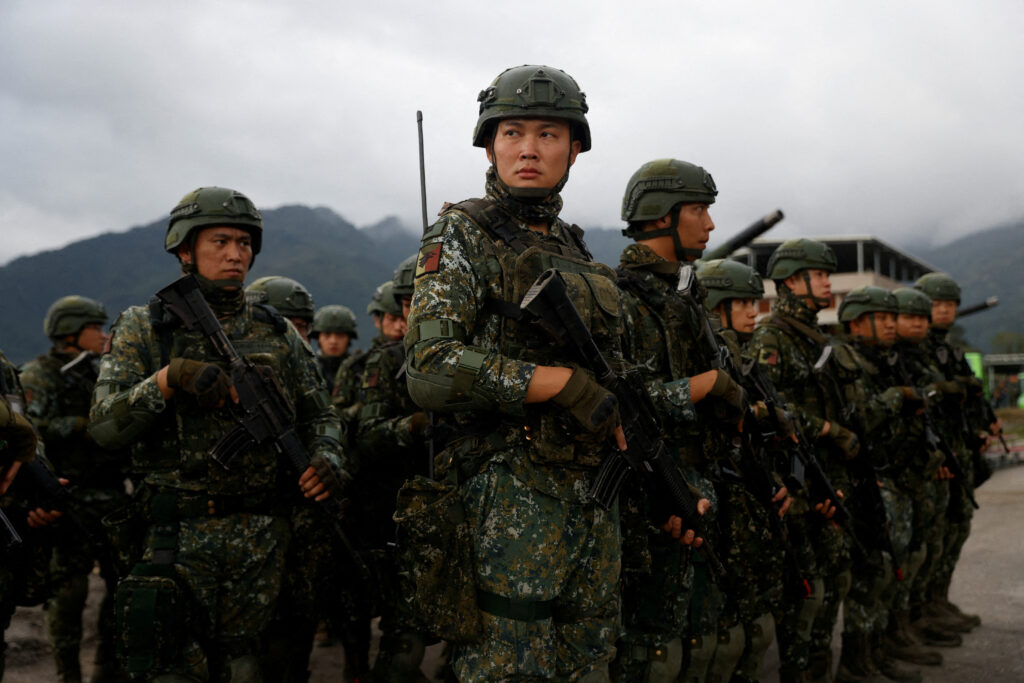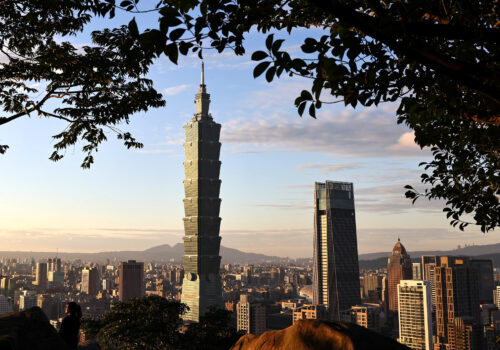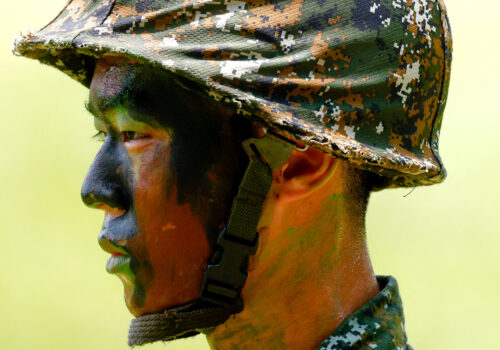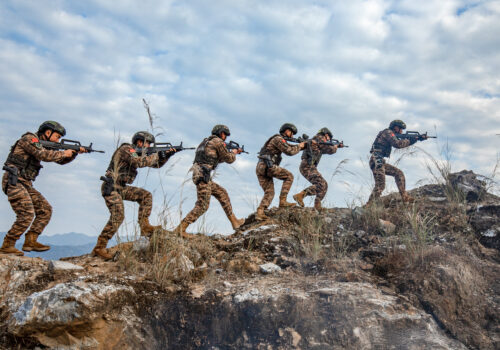
How quickly can Taiwan integrate US weapon systems? Speed is essential to help deter China.


Click on the banner above to explore the Tiger Project.
Over the past few years, discussions on Taiwan’s military readiness have honed in on the long delays in processing and delivering US weapon systems to Taiwan while China’s capabilities are rapidly growing—putting deterrence at risk. However, delivery is just one step in the process of integrating weapons within Taiwan’s armed forces. The full integration process extends beyond the weapons arriving on the island’s shores.
The period between delivery and integration is often invisible to the public, but it is a danger that I covered during my time as a foreign policy advisor in the US Senate. It is driving a strategic risk of failure for Taiwan’s porcupine strategy of signaling that the island is too costly a meal for China to digest, and Washington and Taipei must urgently address this issue before Beijing moves to take advantage of the delay with military aggression.
Defining the problem
The timeline for integrating weapon systems has remained largely hidden in part because the US Department of Defense uses vague and often subjective terms to define a country’s ability to integrate systems. Like any recipient country, Taiwan is reluctant to advertise weapon integration delays to its adversaries. Despite these challenges, the US Department of State and US Department of Defense are required by statute to certify to Congress that a country can integrate a weapon system being delivered. This is enumerated as a country’s “ability to absorb” within major weapon sales notices to the appropriate congressional committees and later to the public.
At the machine level, this assessment is required by the specific country team managing the sale. It must occur before the Defense Security and Cooperation Agency (DSCA), the Department of Defense’s lead agency for arms sales, formally submits the sale for approval to Congress or to the executive branch. While the DSCA proclaims that a country has the ability to absorb a weapon system, there is no formal definition of the criteria that leads to this conclusion. Instead, the DSCA uses two terms to measure the level of weapon integration: Initial Operational Capability (IOC) is defined as “when some units and/or organizations in the force structure scheduled to receive a system have received it and have the ability to employ and maintain it.” Full Operational Capability (FOC) is when a recipient military can fully utilize a delivered capability. Both terms are subjective benchmarks of progress after a system is delivered, not an assessment of a country’s ability to integrate the system prior to delivery, which is required by Congress.
Lessons from the Harpoon system
In Taiwan’s case, the ambiguity of absorption timelines is particularly concerning due to China’s commitment to unify Taiwan with the mainland by “all necessary means.” This rhetoric has led to fears of a near-term Davidson Window invasion, in which China engages in a violent struggle to control Taiwan by 2027. In order to deter China, many in Washington and beyond have focused on asymmetric capabilities, such as the Harpoon anti-ship over-the-horizon missile system, especially given the naval and amphibious center of gravity of any direct military action against the island nation. This has culminated in the order of four hundred land-launched Harpoon systems, with delivery expected in 2028. Taiwan will certainly achieve IOC and FOC status with Harpoons, but how long will it take? And what will this FOC look like given the subjective benchmark?
There are reasons to be concerned about how long it takes Taiwan to absorb deliveries. For example, questions were raised within Taiwan’s own Legislative Yuan about the Ministry of National Defense’s ability to expand its anti-ship missile forces. Discussions within the Legislative Yuan focused on the staffing and retention of these specialized forces as key limiting factors to their expansion prior to the arrival of the US Harpoon systems. Despite these worries, Taiwan has pushed forward. Earlier this year, Taiwan’s military sought out bids for the construction of bases for the new anti-ship missile units expected to use the Harpoon system. In addition, Taiwan appears to be developing the command structure to manage this expanded force.
However, the elephant in the room remains the manpower requirements. With recruitment challenges and reductions in overall recruitment goals and force posture, it is unclear where the new manpower will come from without direct political intervention by Taiwan’s leadership. With the delivery of the Harpoon system already delayed, how much longer would it take for Taiwanese forces to integrate the system and reach IOC and FOC status with its manpower deficit? One proposed response is to deliver as many US weapons as possible to Taiwan, and this is not without merit because resupply once a crisis begins is unlikely. Ukraine, for example, has shown incredible battlefield absorption and innovation with new technologies after Russia launched its full-scale invasion in 2022.
But the challenges facing Taiwan are different. Taiwan is not bordered by NATO partners and does not have the same ability for relatively unchallenged allied resupply if China commits to reunification by force. This also means that multilateral training efforts that have enabled the West to train Ukrainian pilots on the F-16, among other systems, as well as US bilateral security training programs, are not feasible once hostilities commence due to the high risk of movement within the Taiwan strait or residence on the island. Furthermore, Taiwan has large population centers along coastal cities, so there is little space to retreat and carry out conventional resistance if China has local sea control and conducts an amphibious invasion. This means that outside of a more guerrilla-style campaign, Taiwan needs to be ready for an invasion on day one and cannot trade land for time like Ukraine.
Recommendations
To better assess and reduce delays between delivery and implementation, Washington and Taipei should take the following steps:
1. Understand the delay. The United States and its allies and partners cannot address Taiwan’s military readiness until they understand how a weapon integration timeline extends when Taiwanese forces can actually use a delivered capability. The good news is that some in the US Congress are beginning to acknowledge the challenge within this hidden timeline. Last year’s Senate version of the National Defense Authorization Act (NDAA) included Section 1366, which was introduced by Senator Joni Ernst (R-IA) while I advised her on foreign policy issues. Section 1366 requires the Department of Defense to provide Congress with a classified report on the time it took for Taiwanese forces to reach IOC and FOC with the systems the United States have sent over the last ten years. Unfortunately, this provision was downgraded from a legislatively mandated report to a committee briefing during the NDAA conference process. This legislation should be included in the NDAA for Fiscal Year 2025 and the Senate Armed Services Committee should ensure that it receives the requested briefing on the specific weapon timelines beyond vague assurances.
2. Expand and accelerate training. The Department of Defense should accelerate and expand the use of its institutional capacity-building authorities under 10 U.S.C., Ch. 16, §§ 332 & 333, which enable the US military to work with partner countries to help achieve FOC status with US weapon systems. It has already been publicly revealed that US forces are in Taiwan. However, it is unclear if the current institutional capacity-building program, as directed by the US Congress in Section 1309 of the NDAA for Fiscal Year 2024, is addressing absorption challenges. Allied governments who are providing capabilities to Taiwan should also assess the speed of integration of their provided capabilities and offer additional training if required.
3. Ensure manpower requirements can meet weapon deliveries. Taiwanese President Lai Ching-Te of the Democratic People’s Party and the Legislative Yuan, currently controlled by the rival Kuomintang Party, should work together to increase defense spending and military readiness. This requires ensuring that more new voluntary military recruits and conscripts are familiar with or trained in manning asymmetrical systems, such as the Stinger, Javelin, and Harpoon missiles. This also means ensuring that new anti-ship missile squadrons are fully manned once their new bases are built and weapons arrive.
4. Mandate or prioritize capabilities that can be integrated quickly. Finally, weapon deliveries by both the United States and allied countries should be focused not only on what Taiwan may need to deter and defeat China, but also on what can be quickly integrated into Taiwan’s military. New systems that do not fit the current force structure and specialization of Taiwan’s military must be selected sparingly and based on whether they will help Taipei achieve its porcupine strategy.
Understandably, this is a highly sensitive issue. If the US government openly admits that Taiwan may be unable to use the systems already behind schedule for delivery, it could incentivize Beijing to seek unification by force. However, allied policymakers need to understand Taiwan’s current capabilities and the time it will take to use the new systems they are delivering, even in a classified or nonpublic setting. If gaps exist, which public reporting indicates is the case with some capabilities, then the United States and allied countries must either rapidly address these integration gaps or provide systems that Taiwanese forces are capable of using on arrival.
Adam Kozloski is a nonresident senior fellow in the Indo-Pacific Security Initiative at the Atlantic Council’s Scowcroft Center for Strategy and Security. He formerly served as Senator Joni Ernst’s foreign policy advisor. Ernst introduced Section 1366 on Taiwan’s absorptive capacity in the Senate NDAA for Fiscal Year 2024.
Further reading
Tue, Jul 2, 2024
Strengthening Taiwan’s resiliency
Report By Franklin D. Kramer, Philip W. Yu, Joseph Webster, Elizabeth Sizeland
Resilience is a nation’s ability to understand, address, respond to, and recover from any type of national security risk. Given the scale of risk Taiwan faces from mainland China, domestic resilience should be front and center in Taiwan’s national security strategy, encompassing areas such as cybersecurity, energy security, and defense resilience.
Fri, Jun 28, 2024
Dispatch from Taipei: Why Taiwan’s survival may depend on deterrence through resilience
New Atlanticist By Markus Garlauskas
A repeated theme in recent discussions in Taipei was Taiwan’s ability to withstand Chinese coercion and to adapt and sustain its defenses while under attack.
Fri, Jun 14, 2024
Think China can already take Taiwan easily? Think again.
New Atlanticist By Brian Kerg
Beijing’s influence campaign in pursuit of a “cognitive fait accompli” against Taiwan is conducted across multiple lines of operation.
Image: Members of Taiwan’s armed forces stay in formation during a drill as part of a demonstration for the media to show combat readiness ahead of the Lunar New Year holidays, at a military base in Taitung, Taiwan January 31, 2024. REUTERS/Carlos Garcia Rawlins



